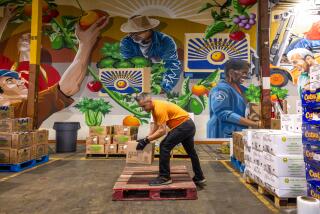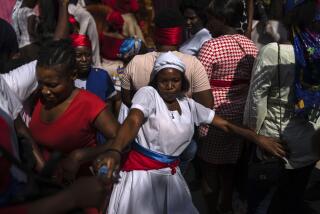Haiti’s mango farmers get help growing the industry
- Share via
Reporting from Saut d'Eau, Haiti — — A mango trapper muscles his way high up the tree, then stops on a branch. Spotting a hanging fruit, he pushes his homemade picking pole forward, trapping it.
He then drops the kidney-shaped Madame Francis mango to a teenage boy who holds out a rice sack to break its fall.
It’s a homespun harvesting technique that helps feed about half a million Haitian peasants, but one that is also keeping the $10-million- to $12-million-a-year industry from reaching its full potential.
“We would like another way to pick the mangoes,” said Ernst Excellent, 22, one of hundreds of fournisseurs, or middlemen, who wander Haiti’s rugged terrain in pursuit of mangoes, most of which end up in U.S. supermarkets. “We don’t have any help. We don’t have any specialist telling us what to do or what not to do when we are planting. If we had someone, we could grow more mangoes.”
As Haiti seeks to rebuild after the Jan. 12 earthquake, so does the country’s challenging mango industry. One of the few bright spots even before the magnitude 7.0 quake, mangoes and the peasants who grow them have become key in helping put revenue back into this quake-shattered economy.
“Right now, there are a lot of opportunities,” said Maria Teresa Villanueva, a senior project officer with the Inter-American Development Bank. “We think relief and reconstruction are very important, but we also need to work on economic recovery to make Haiti’s long-term development possible.”
The momentum to help Haiti’s mango industry began well before the quake but has picked up since. For instance, weeks before this year’s season opened, Coca-Cola Co. executives held a reception during an international donors conference for Haiti in New York and unveiled a new juice, Haiti Hope Mango Lime-Aid, to help Haitian mango farmers.
Still, it will take more than a new juice to make Haitian mangoes soar in profits.
In recent years the industry, because of the lack of groves, has struggled to control a fruit-fly problem that caused the U.S. Department of Agriculture to temporarily suspend exports. Also, terrible roads and farmers’ poor handling techniques mean 40% to 60% of mangoes are lost before they even arrive at the plants where they undergo a hot water bath before being exported.
And then there are the country entrepreneurs like Excellent, who put entire villages to work during mango season but hold the fate of the industry in their callused hands.
“A farmer can’t fill up a truck by himself,” said Jean-Maurice Buteau, a mango exporter who recognizes the value of middlemen but says that with new regulations and controls being placed on the industry, small farmers are key.
“With minimum support, they can generate more wealth and be greater contributors to their community and the country.”
In the meantime, others are on the ground, helping organize growers and seeing how a country that produces mangoes year round can better reap the benefits at a time when demand for mangoes is up in the United States.
Under the initiative by the Inter-American Development Bank and Coca-Cola, the goal is to double the income of 25,000 Haitian farmers by giving them access to loans and markets and by teaching them new techniques to harvest the fruit.
“The key is to work with farmers who have the potential to increase their Francique production from perhaps 10 trees, to plant another seven to 10, and for the existing trees to be more productive,” said David Williams, regional director for Latin America and the Caribbean for TechnoServe, a nonprofit handling the $7.5-million, five-year IDB-Coca-Cola project.
Williams said the ultimate goal is to supply not only the fresh export market but also puree from Haitian mangoes for Coca-Cola’s Odwalla line of juices.
“Haiti is a natural location with an untapped supply that has not been improved upon, and focus on the right varieties,” he said.
Haitian Agriculture Minister Joanas Gue welcomed the initiative, saying organizing farmers allows them to deal directly with exporters and ultimately control their own destinies.
IDB’s Villanueva said there is no reason why Haiti’s farmers can’t organize. “It has worked in other countries; I don’t know why it wouldn’t work here,” she said. “It’s just a matter of showing them what they can do.”
Before the quake, the IDB’s investment sections provided local mango exporter CariFresh with $1.15 million in loans and grants to expand its family-run business. The money is to be used to help train and organize farmers who currently supply the company’s mangoes, and with a grove the company recently planted near its Croix de Bouquet factory.
CariFresh is investing $800,000 in the project, IDB spokesman Peter Bate said.
“It’s a turning point and an opportunity to not only increase your supply, but at having a hand in educating the people who take care of the mangoes,” said Cassandra Reimers, company vice president.
Charles writes for the Miami Herald/McClatchy.
More to Read
Sign up for Essential California
The most important California stories and recommendations in your inbox every morning.
You may occasionally receive promotional content from the Los Angeles Times.













